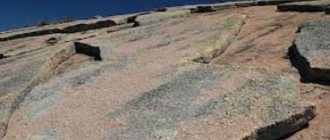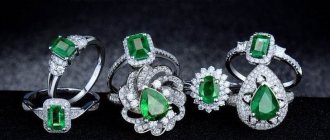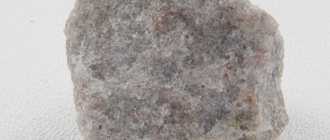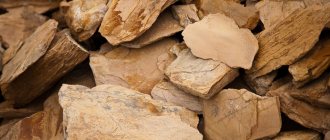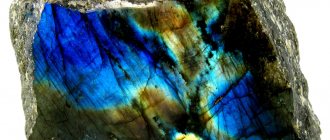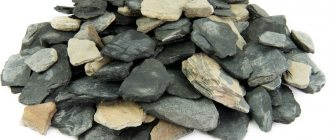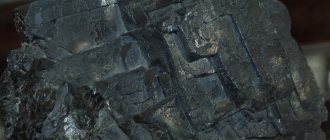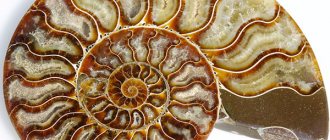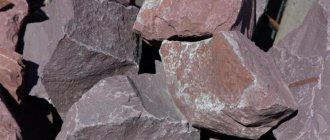- Encyclopedia
- The world
- Granite
Granite refers to rocks formed during the solidification of magma. This is a very hard material. Granite is the foundation of all continents and is widespread on Earth. But it is nowhere to be found in space: neither on the planets of our solar system, nor in meteorites.
This rock contains several minerals. The main components are quartz, which is interspersed with granite grains and creates a beautiful rock pattern, as well as feldspar. Quartz gives a special hardness to the stone. Mica is also present in its composition. During the weathering process of this rock, kaolin (white clay) is formed.
The main industry for using granite is construction, since the material does not absorb moisture at all, it does not get dirty, and can withstand low temperatures. It is used for interior or exterior decoration. The only disadvantage of the rock is its natural radioactivity. Certain varieties of granite are used to produce uranium.
Granite comes in a variety of colors: pink, greenish, blue and even yellow, but gray is more common. Its pattern is heterogeneous, includes grains of various sizes and stripes, which makes granite a very beautiful material. Translated from Latin, granite means “grain”. Fine-grained rock is considered stronger and more durable. An artificial analogue is porcelain stoneware, obtained by pressing and firing at temperatures above 1000 degrees a mixture of quartz, clay, spar and water.
After polishing to a shine, granite is used to make countertops, stairs, columns, and used to decorate fireplaces and fountains. Many monuments are made of this durable material. Everything made of granite is practically eternal, resistant to various mechanical influences, does not wear off or be scratched. Granite is often used in the construction of metro stations.
Granite is not easy to mine, because it must be extracted in whole blocks, without destruction. Blocks are chipped or cut from the blocks. Sometimes a hole is made in the rock and explosives are placed, after the explosion the block breaks into large pieces.
During the processing of rock, a lot of granite chips are formed. It is added in the production of paving slabs, pouring asphalt, and building foundations. Crumbs have found application in landscape design: they cover paths in gardens with it so that puddles do not form on them.
What is granite
Translated from Latin - grain. Natural granite is formed in nature over millions of years. There are 2 known types of origin of the stone:
- Volcanic. The frozen lava of a volcano cools down and acquires a rocky structure. Over many years, granite stone crystallizes in it in the form of grains of different sizes. The process of turning sand into granite takes place along the same path.
- Granitization. During the tectonic displacement of continental plates, different rocks moved deeper into the earth. High temperatures and pressures coupled with chemicals caused granitization.
It contains rocks:
- potassium feldspar;
- quartz;
- mica;
- acidic plagioclase;
- amphibole.
Sometimes additional components are found (pyroxene, graphite, talc and others).
In percentage terms, granite consists of minerals:
- 60–65% – feldspars;
- 25–30% – quartz;
- 5–10% – dark flowers.
It turns out that granite is a mixture, not a pure substance.
It has a crystalline granular structure with crystals of large (more than 5 mm), medium (up to 2–5 mm) and small (up to 2 mm) sizes. There may be small empty cavities inside the stone (microlite granite) or cavities filled with other minerals (cellular or drusy granite).
View this post on Instagram
Posted by Travertine, Granite, Glue Almaty (@airo_group) Jun 20, 2021 at 10:00 PDT
Composition of granite
Granite is a rock consisting of mineral grains firmly bonded to each other. The size of the grains does not exceed a few millimeters; in some varieties, the size of the minerals reaches 3–5 cm.
The composition of granite is dominated by feldspar of various compositions in the form of plates with a stepped surface (60–65%). The color of granite depends on the composition of feldspar: light gray, pink, brick red. In Transbaikalia, a variety of granite with green feldspar, amazonite, is mined. On the coast of the White Sea, white feldspar with a blue “bunny” inside is found. It is called belomorite or moonstone.
Rice. 1. Belomorit.
Labradorite is not found in granites - almost black feldspar with blue, green, and golden highlights in the depths of the stone. That's why there are no black granites.
Granite and its varieties are the only igneous rock that contains quartz (25–35%). It is observed in the form of colorless or gray grains of irregular shape, similar to pieces of glass.
The mica in granite is dark brown (biotite), sometimes gray (muscovite). These are thin-layered small plates. Content - 5–10%.
Minerals of titanium, zircon, and iron are present as impurities.
Types and colors of stone
The different components that make up the stone, as well as their concentration, determine a wide range of color options. The most famous is gray (light or dark gray shades). Other shades:
- pink;
- lilac;
- orange;
- yellow;
- red;
- blue;
- blue;
- green;
- beige;
- brown;
- white;
- black.
Black gabbro granite has a special texture. When processed, you can get a perfectly smooth shiny surface. Granite stone has various patterns - spots, inclusions, striped-wavy patterns, rings.
Geochemical classification of the White and Chappell granitoids
Types of stone in terms of geochemical aspects:
- S – product of melting of metasedimentary rocks;
- I – the result of melting of metamagma substrates;
- M – formed from magmas containing tholeiitic and basaltic rocks;
- A – consists of incoherent chemical elements.
Classification by grain structure
Based on grain structure, they are distinguished:
- Porphyritic. There are protruding long inserts of quartz, microcline, and orthoclase.
- Pegmatoid. A uniformly grained stone with a symmetrical arrangement of grains.
- Rapakivi. Finnish granite stone. It has red round inserts with a gray frame.
- Gneissic. A classic specimen characterized by a fine-grained texture.
Names of stones based on mineral composition
According to mineral composition:
- Alaskite – dark-colored minerals are absent.
- Leucogranite – there are few dark colors.
- Biotite – the content of this mineral in the stone reaches 6–8%.
- Double-mica granite contains both biotite and muscovite.
- Lithium fluoride – the composition contains lithium mica.
- Alkaline – a large percentage of alkaline compounds.
- Pyroxene – content of orthoclase, quartz, augite.
What color is granite?
Granite with a striped-wavy pattern
It may not be the most colorful stone, but its palette is far from poor. In first place is gray granite. These tones determined the types of feldspars - an essential component, without which the mineral composition of the stone is unthinkable.
Decorative varieties include amazonite, in which bluish-greenish tones predominate. There are pinkish, orange, and red colors of granite.
Quartz, another important component, often produces colorless grains in its texture, but there is also black quartz, black granite. Amethyst crystals with a lilac-pink tint are very beautiful, and an exceptional rarity is a mineral with blue quartz.
The pattern of the stone largely depends on the accumulations of dark-colored inclusions - varieties of feldspar and quartz and is characterized by uniformity. The most popular pattern of the mineral is spotted, speckled. In second place are striped-wavy patterns. Less commonly observed are chains of “rings” of dark quartz and black biotite.
It is beautiful if the stone has inclusions of sparkling spar crystals, which can have a flat shape. If they are elongated along the axes in one direction, then when sawing, a striped-dotted pattern is obtained. Thanks to these features, the breed is an excellent decorative material.
History and origin of the breed
Data on the existence and use of granite in construction have appeared since the times of the countries of the Ancient World: Rome, Egypt, India. For the first time in 1596, the name was mentioned in science in the work of Caesalpinus “De metallicis”. In his work, the Italian naturalist used the Latin word “granum”, which means grain, as a basis.
Due to its strength, reliability, and durability, geologists have called granite the calling card of the Earth.
View this post on Instagram
Posted by Natalya (@natali_kravchenko_) Apr 7, 2021 at 3:17 PDT
Physical properties of granite, description of the rock
The physical properties of granite are determined by its special composition. The stone or crystal contains mica, quartz. It is extracted from a volcanic avalanche. Today, as in the old days, crystal is used in construction. Scientists are studying the beneficial properties of granite. It is believed that it brings good luck. Sights made of natural stone retain their original appearance for centuries.
Extraction of natural material
Granite is found deep underground. It is formed when magma solidifies. Gray granite is often used in construction.
The properties of class 4 granite depend on the size of the grains. There are the following types of crystal:
- coarse-grained;
- medium grain;
- fine-grained.
The finer the grain, the stronger the material. Rock deposits are found deep underground, but in some places on our planet they come to the surface.
A large amount of granite is mined in Finland, India, and northern Russia. The deposits are massive layers. Their extraction is expensive.
Special crystal composition
Granite is also called a mineral. It includes several valuable substances. The main component is feldspar. The color of the stone depends on its quantity. The crystal is one-quarter quartz. This material has soft blue grains.
The stone also contained 20% mica. Other materials:
- iron;
- manganese;
- ilmenite
Place of Birth
It occurs in the form of batholiths - huge massifs with a large area. Sometimes it occurs in layers, alternating with other rocks.
Mined on all continents. There are large deposits in Somalia, Ethiopia, Namibia, USA, Italy, Germany, Finland, Great Britain, France (Pink Granite Coast).
In former USSR countries:
- Mokryanskoye field in Zaporozhye region (Ukraine);
- Malokokhnovskoye field in Poltava region (Ukraine);
- Mikashevichi in the Brest region (Belarus);
- Kordai district (Kazakhstan).
In Russia, granite deposits have been found in Karelia (Dymovsky, Kashina Gora granite, Letnerechensky, Ladoga, Serdobolsky), Eastern Siberia, the Urals (Kamenogorsky, Malyginsky, Rezhevsky, Sukhovyazsky, Malyshevsky), the Caucasus, the Far East, Bashkiria (Mansurovsky granite, Tashmurunsky deposit ), Central Russia (Pavlovskoye field).
Many types of stone are named after the deposits where they are mined. For example, red representatives extracted from deposits of the same name: Leznikovsky, Mezhdurechensky, Simonovsky, Emelyanovsky, Tokovsky, Kapustinsky. Gray specimens: Korninsky, Sofievsky, Zhezhelevsky, Pokostovsky.
Not only Russian granite is of good quality, but also Chinese, Indian, Brazilian, Ukrainian (Yantsevsky, Tansky, Vasilyevsky, Korninsky).
To watch a video of how the extraction of useful minerals occurs:
Granite is a mineral
Granite is a crystalline rock found in mountainous areas and consists of feldspar, mica and silicon oxide. The breed can be found on all continents of the planet.
Due to the crystallization of magma at different depths under the earth's crust, solid minerals of different configurations and sizes are formed. In some cases, it appears on the surface of the earth due to the destruction of the sediments that covered it.
It is a natural stone with a fine, medium or coarse grain structure. The stone has a wide range of colors and a variety of shades: black, burgundy, gray, white and with various inclusions. The shade depends on the percentage of minerals contained in granite.
Throughout Russia, there are up to 50 places where granite is formed, which is used as a piece stone. The largest deposit of beautiful stone was discovered in Ukraine.
Advantages of granite.
1. High-quality granite with fine grain is durable and does not undergo destruction for 500 years.
2. Resistant to abrasion, friction and compression. The stone has a density of 2.6-2.7 t/m, and a strength of up to 250 MPa.
3. Granite is not affected by weather conditions and acids. Excellent for finishing the exterior surface of a building.
4. Waterproof. The material does not absorb moisture and is suitable for use in the construction of embankments.
5. Radiation-safe and environmentally friendly stone.
6. Variety of textures.
7. Good compatibility with other construction, finishing and decorative materials that fit perfectly into all design solutions.
8. Large range of colors. The most common granite is gray, less common are red, pink, orange and green.
Granite is a universal material and is widely used in construction:
— floors on staircases, thanks to their abrasion resistance;
— window sills, cornices, countertops, columns, railings are not subject to mechanical damage due to the increased strength properties of the stone;
— a variety of textures for finishing the facade and interior;
— landscape design details;
— bridge supports, steps and paving stones;
— stone does not absorb moisture and is used for finishing embankments.
Stone processing
The stone is very durable. You can split granite stone with a hammer, cleaver, or sledgehammer. You can break the stone into two parts, split it into several large parts, knock off some parts (shards) or trim it, giving it the desired shape, creating edges - smooth surfaces (faceted granite).
During processing, diamond drills are used for cutting and grinding. It is easy to give the source the desired shape using a tesque. Sometimes heat treatment is required. Heat-treated granite has a rough surface. Bush hammered granite also has such a surface. The essence of the treatment is the shock-rotational effect of special sprockets made of hard alloys.
On the map, the symbol for granite is crosses (pluses) in a frame.
Also watch the program about processing:
How is granite mined?
The only disadvantage of granite is the difficulty of mining and processing. The stone is polished exclusively with diamond tools. It remains a mystery how huge stones were previously mined to build majestic palaces.
There is an assumption that in ancient times stones were separated from the massif with copper saws using corundum as an abrasive. Modern experiments prove that this is possible. Although there are opponents to this theory. They argue that the nature of the marks on the stones suggests that tools similar to modern diamond cutters were used. But archaeological excavations do not confirm this theory. Scientists have found only the simplest tools.
In Peter's times, to separate granite blocks, recesses were drilled into the base of the massif, and posts were driven into them. The work was done until the first vertical crack. Then, shafts were drilled into the stone to store gunpowder. The explosion broke off the plate. Using the same method, the stone was broken into smaller pieces.
Nowadays stone mining is carried out in a similar way. Holes up to 7 meters deep are drilled in the massif, explosives are placed in them, with the help of which the slab breaks off.
How to distinguish natural granite from artificial
There are several signs that will help distinguish a real stone from a fake:
- Temperature. The original is cold. It takes a long time to gain temperature if you hold it in your hands. The fakes get warm quickly.
- Resistant to damage. Artificial analogues are easily scratched, unlike a natural sample.
- Drawing. Real stone has unique patterns that are not repeated. Imitation may have repetitions of some elements.
- Shine. The original is always matte, but a fake can be too shiny.
- Price. The suspiciously low price of granite products should alert you.
Description of Granite report
Granite is very popular and widespread among rocks of natural origin. As a favorite material of designers, builders and architects for many millennia, its beneficial properties prove the need for frequent use.
Granite is formed thanks to two methods, one of which is associated with the gradual solidification of a hot magmatic mixture in the bowels of the earth. Thanks to this origin, it takes on the appearance of grains. This method of forming volcanic rock is widespread. In addition, granite can be the result of compression under high pressure of clastic, sedimentary rocks, which are subject to the movement of tectonic processes, ultimately ending up at depth. This is how the crystalline form of a rock is formed.
Depending on what stones are included in its composition and in what condition, the color characteristics may be different.
Pink and orange colors of granite indicate the presence of predominantly spar in it. Black and white material with inclusions indicates the presence of quartz. The red color indicates the presence of iron oxide. The deposits of China are known for natural stones with a green tint. Iron gives granite its brown color.
This rock occurs on every continent of the Earth, but everywhere it is unique. The structure of the stone is the same type - in the form of grains, but differs in size - from small to large, depending on the method of formation.
Due to its rich color palette, granite is in great demand for creating details in interior design. Landscape design specialists pay attention to its shine, as well as the surface that can be chosen, taking into account the customer’s desire - from smooth to rough. The great demand of granite for the construction of monuments is explained by the fact that it can be cut and easily polished.
In addition to its decorative properties, natural stone has found application in cladding facades and staircase steps due to its ability to withstand exposure to any temperature. And special processing of granite makes it possible to achieve such properties as resistance to slipping. It is frost-resistant, waterproof, and has no restrictions on use, which is why it is used in lining embankments. Cladding of houses is necessary, first of all, due to fire resistance.
Several characteristics of granite explain its widespread use in the construction industry. When compressed or during friction, its special stability is manifested. Thus, the strength of stone is always highly appreciated in the manufacture of furniture parts and countertops.
Of particular value is its safety associated with the absence of radiation and non-hazardous levels of radiation.
The retention of some properties of granite can be so long that this stone rightfully deserves a positive assessment as a durable material. Therefore, it is often used in the construction of buildings.
An interesting fact about granite is that its presence has not been proven on other existing planets.
In Russia, the granite deposit is concentrated in the Murmansk region, where blue stone is mined. Ural granite is also known, distinguished by its red tint. The Far East, Siberia and the Urals are some of the main places of its production.
3rd, 4th grade the world around us
Properties and applications of granite
Most often, stone is used in construction, given its strength, resistance to weather influences and temperatures. It does not absorb moisture, which justifies the use of the material near bodies of water.
Areas of application of natural and artificial materials (porcelain stoneware):
- building cladding;
- design of embankments, central streets, metro stations, underground passages;
- production of countertops, window sills;
- flooring in private properties, museums, theaters;
- design of stairs;
- production of grave monuments;
- addition to road surfacing composition.
The stone is durable, lasting for hundreds of years.
View this post on Instagram
Publication from Bulat (@mozayka_mramor_95_) June 20, 2021 at 10:51 PDT
View this post on Instagram
Publication from the Magazine “House in Details” (@domvdetalyah71) June 22, 2019 at 12:57 PDT
View this post on Instagram
Publication from Diamond Stone (@diamondstone.ru) July 13, 2021 at 5:03 PDT
How does the composition of granite affect its decorative properties?
Decorative properties are affected by impurities in the composition. They give the stone rare shades, for which they are valued on the market.
- Green – Green Ukraine, Maslovsky (Verde Oliva), Butterfly Green.
- Blue – Ultramarine, Sodalite Blue, Azul Macaubas.
- Reds - Imperial Red, Syuskyuansaari, Kapustinsky, Leznikovsky.
- Yellow – Sunset Gold, Crystal Yellow.
- Brown - Dymovsky, Elizovsky.
- Tsvetnoy – Didkovichsky, Yuzhno-Sultaevsky, Beinbook Brown.
- Black – Absolut Black, Black Galaxy, Gabbro-diabase, Bukinsky.
Physicochemical characteristics
Granite is famous for its strength, which is almost 2 times the strength of marble (see comparison of granite and marble). It is resistant to precipitation, acids, frost, and heat. Does not absorb moisture, fireproof.
Maintains external aesthetics for many years, despite external adverse influences. Clay and sand are formed when granite breaks down under the influence of sun, water, wind, and living organisms.
- Density: 3.17 g/cm3.
- Hardness on the Mohs scale: 6–7 points.
- Specific gravity: 2.7 g/cm3.
- Abrasion: 1.4 g/cm3m.
- Compressive density: 300 mPa.
- Compressive strength: 299.6 MPa.
- Bending strength: 57 MPa.
- Radioactivity of granite: weak, contains a small number of isotopes. Requires measurement with a device.
- Electrical conductivity: none.
The chemical formula is long, depending on the composition: SiO2 – 70.18; Al2O3 – 14.47; K2O – 4.11; Na2O – 3.48; CaO – 1.99; FeO – 1.78; Fe2O3 – 1.57; H2O – 0.84; TiO2 – 0.39; MnO – 0.12; MgO – 0.88; P2O5 – 0.19. The percentage of elements is indicated through a dash.
Medicinal properties
In lithotherapy, the stone is used to treat bronchopulmonary diseases and diseases of the cardiovascular system. Helps with problems with joints and bones (especially with diseases of the spine). For colds, it helps to quickly reduce body temperature.
Magic properties
People believe that the stone can protect the house from negative energy. This is facilitated by granite decorative elements in the interior or talismans.
Granite amulets help develop intuition. Improves brain function.
As a talisman and amulet, granite helps people associated with mental work (educators, teachers, students, scientists).
In addition, watch the documentary:
Properties of granite stone
This mineral rock is one of the strongest on Earth. It's no joke, the earth's crust - the foundation of our planet - rests on it.
The stone has the highest resistance to many destructive processes: compression, friction, weathering, abrasion.
The best varieties are considered to be fine-grained varieties that can remain intact for 500 years. Only after such a period can the first traces of stone destruction be found.
Hardness on the Mohs scale was rated 7, which is quite high. And if feldspar is responsible for the color of granite, then quartz guarantees hardness and strength. It also provides heat resistance: in order for the solid to begin to melt, it needs to be heated to 700˚C.
Perhaps this is why many ancient stone structures have survived to this day. The density of granite is also above average. A cube of stone with centimeter sides is three times heavier than the same volume of water.
The properties of the stone also include environmental friendliness and ergonomics. All types of natural stone are safe, do not emit radiation, and have no restrictions on their use for construction work.
Application in the interior and how it is used in construction
With the help of granite, designers can create unique, inimitable compositions, highlight individual elements of the architecture of buildings, and make accents in the interior of premises. Granite is an ideal material for exterior decoration of buildings, construction of monuments, memorials, and tombstones. Granite is often used to decorate gardens and parks and install road surfaces.
In the interior, countertops made of liquid stone and window sills are installed. Granite is used to cover the inner surface of walls, floors, fireplaces and other interior elements.
The surface of the material is usually polished, fired or bush hammered. The stone is cut and polished using a diamond.
Bungalow projects.
See this article for the different sizes of floor tiles.Wallpaper design for the bedroom: https://trendsdesign.ru/materialy/oboi/kakie-oboi-vybrat-dlya-spalni.html
How granite is formed
This issue has been the subject of debate for a long time.
Development of theories:
- In the 18th century, it was believed that granite was a sedimentation of crystals on the seabed.
- In the 19th century, they began to believe that granite is magma, which, rising to the surface, captures and sinteres other minerals, cools and crystallizes.
- In the 20th century, another theory was added to the previous one. Granite is the result of hot springs that erode and transform rocks. Some components are washed out, others crystallize and sinter.
Now the last two theories are being developed. It is generally accepted that they both have a right to exist. Some of the granite massifs were formed magmatically, some by granitization.
Use of granite
In fact, granite is widely used in modern times and is very common in people's use. So, where can this breed be used in our time? Of course, first of all, this is industrial production.
Surely you have at least once come across curbs, steps and stairs made from this rock. This is what allows us to conclude that granite is in great demand in construction and architecture. Granite is used in the construction of objects and sculptures, as well as for facing material.
Granite is also very often and widely used for cladding floors and walls in a house or apartment. Granite goes well with marble. Items that are created precisely in the combination of marble and granite have grandeur and attract the attention of others.
Areas of application
Durable rock has been used in architecture since ancient times. Not all people know that the Egyptian pyramids were built using granite. Many structures were built in Ancient Rome and India. The stone, which is characterized by durability, can withstand any climatic conditions. He is not afraid of either wind or rain.
Today, granite is used to make not only various buildings, but also stairs, steps, curbs, and street tiles. The mineral is used in the construction of monuments, sculptures, vases, columns, bridges, benches, artificial reservoirs and other architectural objects. Natural material is often used to create countertops.
The excellent performance characteristics of granite allow it to be used not only for external, but also for internal work. It is used for cladding walls and floors in a house or apartment. Any product made from a reliable building material is easy to use. No complex maintenance is required to maintain the finish in its original form.
When people decide to choose granite for finishing their home, they often doubt the choice of the appropriate stone option. Among the large variety of species, it is difficult to determine which material is considered the best. The choice of mineral depends on the purpose of its use. It should be mentioned that liquid granite, which can replace cement, is a new prospect in construction.
The stone looks harmonious in combination with marble. Items with a combination of these materials look attractive and majestic. And sometimes white granite can replace marble, which it is very similar to after proper processing. Since stone is more durable than marble, during use it does not lose its original shade, structure, or texture. Granite has only one drawback: it has the greatest weight among building materials, which must be taken into account when constructing bridges, monolithic houses and other large structures.
Where else is stone used?
The banks of large rivers are forged in granite, and the fortress walls of old castles are built from it. Huge boulders of this holocrystalline rock adorn national protected areas. And in modern cities, pedestrians admire the granite paving stones under their feet - many embankments and central streets are paved with this stone. Not to mention the fact that it is impossible to count how many monuments and memorial plaques in the world are carved from it. And this is not all that is made of granite. Moreover, modern stone processing technologies expand human capabilities and imagination.
The use of granite since ancient times has had not only aesthetic value, but also a functional side. Today, the stone is polished, ground, the surface of the processed samples has many names - polished, sawn, bush hammered. For certain purposes, the stone is processed by fire. And all this variety of granite materials serves people conscientiously.
Stone makes the most durable, practical countertops and window sills, which are also quite original due to the texture and color of the mineral. There are even fashion trends associated with cladding with this material. If smooth surfaces were once popular, today textured elements are in use. They stipulated the use of granite as a floor covering to prevent shoes from slipping. Walls with textured designs are also in fashion; this gives the interior a rich look and sets the main tone for the style solution.
It is clear that granite’s properties and areas of application are interconnected. Thus, the hygiene of the stone and its moisture resistance make it possible to create sinks and bathtubs from it. In addition, the mineral has high heat resistance, which is only a plus for the material used for such premises. Stone gives a person comfort and aesthetics in everyday life.
And yet, the main thing for which he has been loved for centuries is his presentability. Majestic staircases, magnificent sculpture, harmonious borders and paving stones, monumental structures made of granite have been created and will continue to be created as long as the mineral is formed in nature, as long as reserves of this unique “eternal” stone allow.
Artificial granite, its pros and cons
Artificial stone is a composite material that consists of granite chips and polyester resin. It has many positive characteristics characteristic of natural stone. Its advantages include the following properties:
- low thermal conductivity;
- resistance to moisture, temperature changes, rust and household chemicals;
- hygiene due to the absence of micropores;
- easy to process;
- aesthetic appearance with a wide range of colors and shades;
- absence of radioactive background;
- resistance to heavy loads.
But along with the indicated advantages of artificial stone, the existing disadvantages should be identified. The properties of artificial granite lack the natural hardness of the mineral, which indicates its susceptibility to mechanical stress. Despite the fact that artificial stone has an attractive appearance and shine, it feels far from a natural mineral and resembles plastic. It is also impossible to reflect the unique pattern of a natural mineral in a synthetic analogue.
Ural granite
One of the largest concentrations of granite ore deposits is located in the Urals. Development is carried out from more than 12 mines, the most famous of which are Tashmurunsky, Mansurovsky, Sanarsky, Yuzhno-Sultaevsky, Malyshevsky, Sosnovy Bor and Tsvetok Ural. The age of the mined rocks is about 2.5 million years.
Most Ural granite rocks are gray and light gray in color. The exception is the Malyshevsky, Yuzhno-Sultaevsky and Zapadno-Sultaevsky granites, which have red and pink colors. The lightest of all Ural rocks is Mansurovskaya. The Ural deposits of granite stone are famous for their low, almost zero radioactivity, which allows the material to be used everywhere. Iron content varies from mine to mine - this must be taken into account when choosing a particular material for a specific purpose.
Ural granite has a relatively low cost, which allows it to be used even in road construction. They often decorate premises, building facades, make architectural forms, monuments and decorative elements.
By place of production
Granite deposits are distributed throughout the world. The bulk of granite ore is mined in Russia, Ukraine, Central Asia, central Europe, the USA and Africa. In Russia alone there are over 200 deposits, most of which are located in the Urals, Karelia, the Far East and Siberia.
The most famous deposits in the CIS are:
- Amazonite
. Contains rare and valuable raw materials from which green and blue granite stone is extracted. - Leznikovskoe
. It is famous for its iron and microcline content, the color of the raw materials is red, pink. - Korninskoe, Sofievskoe
. Light granite is mined in many shades.
Some facts about granite
Everyone accepts the fact that this is a very expensive material. But an artificially created mineral polymer stone is much more expensive than its organic, natural counterpart. A natural mineral can justify its cost only by its rare design and size of the monolith.
There is an opinion among people that the graininess and porosity of a material are its disadvantages. The owner of such a stone will constantly put it in order, continuously polish it and apply various hydrophobic compounds to it.
But the tendency of granite to be exposed to high temperatures is also exaggerated; if it has such a low melting point, then why do many castles built from this material still exist? All housewives who have granite countertops can sleep peacefully by leaving a hot frying pan on it.
Also, many are afraid of radioactive radiation from granite. Yes, its level is significantly higher than the radiation of other stones, but the indicator does not exceed the permissible value according to sanitary standards.
How granite differs from marble, read our article →
Granite deposits
Now granite rocks occur close to the surface of the earth's crust and less often on the ocean floor. Their formation occurred throughout the history of the earth. The oldest samples date back to 3.8 billion years.
Initially, feldspar lay far from the surface, at a depth of 10-15 km. But gradually the sedimentary rocks were eroded and weathered, due to which the granite slabs were exposed.
Granite makes up 77% of all igneous rocks near the earth's surface. Its deposits are different. These are small veins of 1-10 meters or huge layers that make up entire granite belts. The maximum depth of such formations is unknown. For example, in Peru, a layer of granite is exposed for 4 km, but this is not the limit.
Granite development is currently underway in many countries. The most famous:
- In Russia, these are the Khabarovsk Territory, Primorye, Transbaikalia, and the Urals. White, gray and brown stones are mined here. In the Leningrad region, Karelia, and on the Kola Peninsula there are deposits of pink, red and yellow stone. Gray-pink granite is found in the Murmansk region.
- Ukraine is famous for red stone.
- In Central Asia: Kazakhstan, Tajikistan, Uzbekistan. Rare green-blue granite is mined here.
- Europe: Bulgaria, Portugal, France, Scandinavian countries. Spain and Sardinia are famous for their light pink granite.
- China, India, Sri Lanka.
- Africa.
- North America.
Australia is rich in granite; there are deposits of blue granite here, but the deposits have not been fully explored and stone mining has not been developed.
Magical and healing properties
It may seem that granite is too simple to have any extraordinary properties. It is too familiar to be used for magical purposes. But experts highlight the following properties:
- changes a person's life for the better. These can be any changes: financially, in love relationships, a change of job or promotion, a change of place of residence;
- relaxes;
- cleans the room from negative energy;
- increases communication skills, helps to find mutual understanding with other people;
- increases intuition, makes a person responsive and flexible;
- has a beneficial effect on joints and spine.
Granite stone is recommended to be used as a talisman for those involved in scientific activities, as it increases concentration, attention, improves memory and stimulates mental activity. By improving communication skills, it helps to choose an approach even to the most careless students.
Granite stone can be used by all people, because it has peaceful energy and is not capable of harming anyone.
Granite is a symbol of masculinity, indestructibility, strength and durability. This is a unique mineral from the very depths of the earth. He survived cataclysms, the emergence of various forms of life, tectonic processes in the thickness of the earth. Now this stone, millions of years old, serves man.
Karelian granite
Karelia is also a rich region for high-quality granite stone. More than 10 large deposits are being developed in Karelia, the most famous are Dymovskoye, Vinga, Kupetskoye, Elizovskoye, Sopka Buntina. Red-pink and dark colors of the stone predominate. There is also a Gabbro-Diabase deposit, the raw materials of which are in demand for the manufacture of ritual products. This stone does not change its appearance for decades and looks good at any time of the year.
Karelian granite is well suited for most applications of this natural stone: it is used to pave squares, used in urban design, and used for exterior cladding of commercial buildings. It is used to make paving stones, small architectural forms, and decorative elements. They make monuments, memorial slabs, tiles and parapets.
